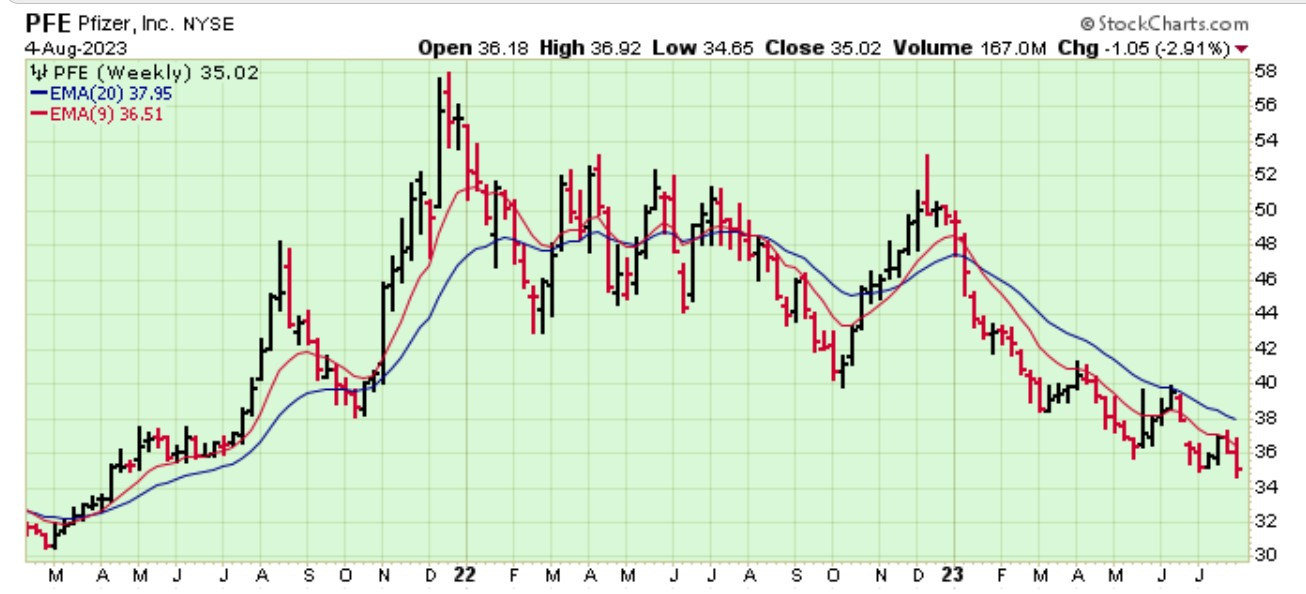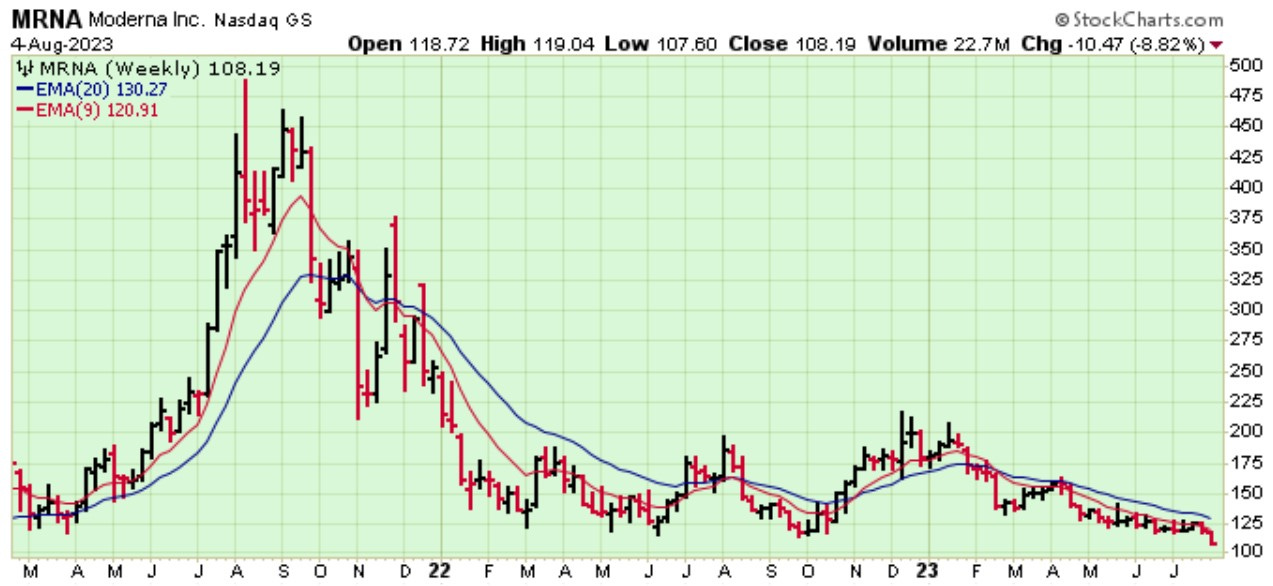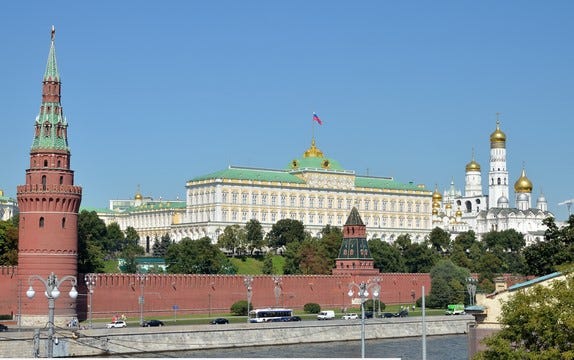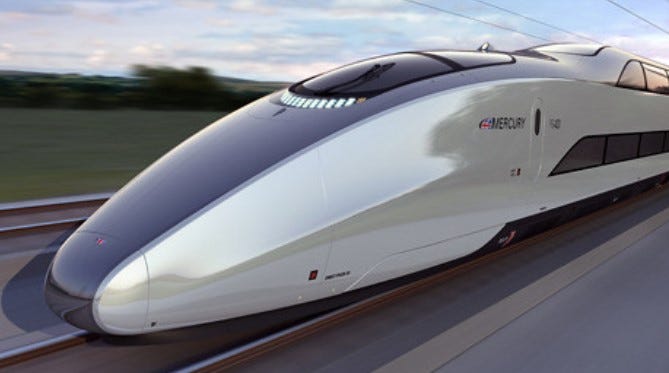This week in BOOM ……….
- PFIZER AND MODERNA STOCKS CONTINUE FALLING
- SHOCKING REVELATIONS IN THE AUSTRALIAN SENATE
- US FREIGHT VOLUME DOWN
- KREMLIN AGAINST BRICS CURRENCY
- 19 NATIONS FROM AFRICA APPLY TO JOIN BRICS
- CHINA INFRASTRUCTURE MASSIVE COMPARED TO THE USA
- US ECONOMY LAGGING CHINA BADLY
- QUANTITATIVE BOOSTING EXPLAINED
PFIZER AND MODERNA STOCKS CONTINUE FALLING
Pfizer shares fell last week by almost 3 %. Pfizer stock is down almost 40 % from its high point, recorded in late 2021. Moderna shares fell by almost 9 % last week. Moderna stock is down 75 % from its high point, recorded in August 2021.
These stocks are in consistent and prolonged downtrends and the trends appear to be accelerating.
Messenger RNA Technology – commonly called mRNA technology – seems to be the culprit here. The new “gee whiz” vaccine technology appears to have major problems attached. The horrible adverse event data is becoming impossible to hide under the “safe” banner. And vaccinated people are suffering repeated episodes of Covid, thus negating the “effective” banner. Safe and effective is being revealed for the lie it always was.
Pfizer on Tuesday reported second-quarter revenue of US $ 12.7 Billion. That is down 54% from the same period in 2022 when its quarterly sales peaked at $27.7 billion. According to some reports, the company now expects 2023 Covid vaccine sales to end down 64% from 2022, while Paxlovid sales are projected to fall 58%. Other estimates are worse.
Reuters reported that Pfizer is considering a cost-cutting program if demand for its Covid products continues to fall sharply. Urgent cost cutting in such a large company usually means that they are worried about their cash flow. During the second quarter, one analyst reported Pfizer Covid Vaccine sales to have dropped by 83% while its anti-viral, Paxlovid sales crashed 98%. BOOM finds those numbers hard to accept. However, the Pfizer Chief Financial Officer David Denton, made this written statement — “The Covid environment continues to evolve rapidly and remains highly unpredictable”.
BOOM has written previously of the danger of a large class action lawsuit from the vaccine injured against all of the Covid Vaccine companies. If such a lawsuit was to be launched, it is theoretically possible that the cash reserves of the companies could be insufficient to survive the threat. It would also be impossible to raise capital in such a situation. A large class action has already been launched in Australia and another legal challenge there involves the argument that the mRNA vaccines are Genetically Modified Organisms (GMOs) by legal definition and which have not received approval for release. However, these games must ultimately be played in the United States for the really big numbers to accrue.
There is also the ongoing problem of rapid mutational change in the SARS CoV2 virus. The current dominant strain is XBB1.5 which makes up 66 % of current mutational registrations globally. At the start of 2023, on 8th January, it was only 2 %. The second most common strain is XBB 1.16. It also appeared in early January. On 19th January, it was less than 1 % of registered mutations. It is now 25 %.
So the two current dominant strains are 91 % of mutational registrations and they were nowhere to be found globally on New Years Day 2023. BOOM wonders how the Covid vaccine companies can keep up with such rapid progress from the virus. It sounds like an impossible task. And it is now common knowledge that the “vaccines” do not stop transmission. Thus, booster doses are in sharp decline.
Last week, the Big Pharma company executives were grilled in an Australian Senate Committee hearing. It was an absolute disaster for the companies with executives clearly unable or unwilling to answer simple questions about their Covid vaccines. It was shocking to watch.
You can watch the destruction here – in just a few short videos. Compelling viewing as the Senators ask probing questions of Pfizer and Moderna representatives.
SHOCKING REVELATIONS IN THE AUSTRALIAN SENATE – THESE SHORT VIDEOS ARE SHOCKING IN THE EXTREME – QUESTIONS FROM SENATORS TO BIG PHARMA EXECUTIVES
https://vladtepesblog.com/2023/08/04/it-appears-that-pfizer-employees-had-a-special-batch-of-vaxx-just-for-them-not-the-same-as-the-public-was-made-to-take/


US FREIGHT VOLUME DOWN
As BOOM has indicated previously, the economies of the US and Western Europe seem to be in deep trouble. Contraction now appears inevitable while the US Federal Reserve and the European Central Bank continue to raise interest rate settings to defeat CPI inflation. But CPI inflation is now rapidly changing to dis-inflation (falling inflation rates). BOOM has indicated that the central banks are now taking enormous risks with their respective economies.
BOOM watches transport parameters closely. Last week the US Bank Freight Payment Index was released. It showed that truck freight volumes are declining. Shipment volume dropped almost 11 % in the second quarter of 2023 compared to the second quarter of 2022.
Bob Costello, senior vice president and chief economist at the American Trucking Associations, made the following statements.
“Trucking is in the midst of a significant slowdown,”
“Weaker consumer demand for goods and a slowdown in manufacturing activity and housing starts are having a major impact on the industry – especially carrier operations.”
The Cass Transportation Index is another measure of what is happening in the US trucking sector. The latest report at the end of June revealed significant falls in the trucking business.
Shipments were down 4.7 % Year on Year
Expenditures were down 24.5 % Year on Year
Inferred Freight Rates were down 21 % Year on Year
The Truckload Linehaul Index fell by 14 % Year on Year
Of course, trucks carry goods and the US economy is very much a services predominate economy. So it is important to keep transportation declines in context.
However, it is certainly worth noting that trucking declines of this degree suggest a significant decline in consumer demand.
KREMLIN AGAINST BRICS CURRENCY
Two weeks ago, in the editorial of July 22nd, BOOM explained that the concept of a BRICS currency was faulty. Currency unions quite clearly rob nations of their individual sovereignty. They are foolish endeavours from an economic viewpoint wherein politicians literally commit the crime of treason against their nation by abandoning their national currency. BOOM also addressed the many problems of establishing a gold backed currency. Using gold as “backing” for currencies was abandoned by the British Empire in 1931 and by the United States in 1971 and for good reasons. Gold has to be priced in such a currency. And therein lies the rub. Where can anyone find a committee of wise and skilful economists capable of pricing gold correctly? Wise and skilful economists are rare creatures.
The Kremlin pitched in last week. Dmitry Peskov, the Press Secretary for Vladimir Putin, addressed the issue of a BRICS currency.
“in the short term, this is hardly feasible, the use of national currencies is already a reality that is growing on a global scale, and this practice is resorted to not only by countries that face sanction limitations, but by those that do not.”
Peskov was obviously sent out by Vladimir Putin to torpedo the endless rumours of a BRICS currency. BOOM agrees – currency unions are a poor strategy for any nation.

19 NATIONS FROM AFRICA APPLY TO JOIN BRICS
Brazil, Russia, India, China, South Africa are the founding BRICS nations. Recent entrants are the United Arab Emirates, Egypt and Bangladesh. And Saudi Arabia has expressed interest along with Argentina, Iran, Ethiopa and Algeria.
At the recent Russia-Africa Summit in Saint Petersburg, it was revealed that 19 other African countries have also applied for BRICS membership in the last 12 months. That is a staggering fact. If accepted along with new applicant Uruguay, these 19 nations would swell BRICS to 28 nations. And there are rumours of another 20 nations lining up to join. 48 nations would be a formidable bloc.
The total population of the current members is approximately 42 % of the global total. If half of Africa were to join, then BRICS would easily be in excess of 50 % of global population. And it is arguable that they could actually represent up to 75 % of the globe. That is a sobering thought.
In comparison, the western US led alliance of advanced economy nations probably represent, at best, 12 – 15 % of the planet’s total population.
Global GDP, measured in US Dollars is about $ 100,000 Billion (100 Trillion) and the United States is about 25 % of that total. However, its population is only 4 % of the global total.
The numbers simply cannot be ignored. Billions of people are aligned against the advanced economy nations in the US alliance. And those Billions of people cannot see how or why the US can or should continue to dominate.
Last week, another nation applied with Bolivia announcing its application to join the BRICS group.
CHINA INFRASTRUCTURE MASSIVE COMPARED TO THE USA
The list of longest bridges in the world illustrates China’s dominance in building new infrastructure. There are 28 bridges beyond 20 Kilometres in length. Of those 28, eighteen are in mainland China and only three are in the United States. Nine of the Chinese bridges are for High Speed Rail. The longest bridge in the US is the one in Lake Pontchartrain in Louisiana. It was built in 1969 – over 50 years ago.

The longest bridge is in China, part of the Beijing–Shanghai high-speed railway, also known as the Jinghu high-speed railway. It is almost 165 Kilometres long. The line is one of the busiest high speed railways in the world, transporting over 210 million passengers annually. Over 220,000 passengers use it every day and there are 244 bridges on the line. The second longest bridge in the world is also on the line. There are also 22 tunnels.
The designed continuous operating speed is 350 km/h (217 mph), with a maximum speed of up to 380 km/h (236 mph).
The high-speed rail (HSR) network in the People’s Republic of China (PRC) is the world’s longest and most extensively used with a total length of 42,000 kilometres (26,000 miles). China’s HSR accounts for two-thirds of the world’s total high-speed railway networks. The Shanghai Maglev is the world’s first high-speed commercial magnetic levitation line. The trains can reach a top speed of 430 km/h (267 mph).
In comparison, the United States has only one high speed rail service, Amtrak’s Acela, which reaches 240 km/hr (150 mph). Its length is only 80 kms (50 miles).
Think about that – the entire US high speed rail “network” is half the length of just one bridge in China. The US “network” is 80 kms long versus 42,000 kms in China.
US ECONOMY LAGGING CHINA BADLY
This comparison makes it ultra clear that the US economy is now severely lagging the Chinese economy over time. It illustrates the failure of Western capitalism versus Chinese capitalism. The western version is unfortunately dominated by private banking interests. In China, the government controls the bankers through sophisticated management of its money supply system. China essentially uses three levers of money control. They are (1) interest rate settings (2) BOOM’s Quantitative Boosting system (QB) plus (3) it allows and promotes the use of physical cash.
Physical Cash volume is an important third tool of monetary policy that must be employed as a buffer against excessive creation of credit money (money created as a commercial bank loan to a willing borrower).
The West can and must learn from China how to better manage its money supply system in a more sophisticated way.
QUANTITATIVE BOOSTING EXPLAINED
QB Explained: https://boomfinanceandeconomics.wordpress.com/2019/12/15/boom-as-at-15th-december-2019/
And BOOM’s Perfect Economy: https://boomfinanceandeconomics.wordpress.com/2020/01/18/boom-as-at-19th-january-2020/
In economics, things work until they don’t. Until next week, make your own conclusions, do your own research. BOOM does not offer investment advice.
Subscribe to BOOM Finance and Economics Substack here —
https://boomfinanceandeconomics.substack.com/
By Dr Gerry
BOOM has developed a loyal readership over 5 years on other platforms which includes many of the world’s most senior economists, central bankers, fund managers and academics.
HOW MOST MONEY IS CREATED
BANKS CREATE FRESH NEW MONEY OUT OF THIN AIR
(but they always need a Borrower to do so)
THERE IS NO SUCH THING AS A DEPOSIT
BANKS PURCHASE SECURITIES, THEY DON’T MAKE LOANS
BANKS DON’T TAKE DEPOSITS, THEY BORROW YOUR MONEY
Watch this short 15 minutes video and learn as Professor Richard Werner brilliantly explains how the banking system and financial sector really work.
How is Most New Money Created ?
LOANS CREATE DEPOSITS — that is how almost all new money is created in the economy (by commercial banks making loans).
From the Bank of England Quarterly Bulletin Q1 2014 —
“Whenever a bank makes a loan, it simultaneously creates a matching deposit in the borrower’s bank account, thereby creating new money.““Most money in the modern economy is in the form of bank deposits, which are created by commercial banks themselves”.
YouTube Video — https://www.bankofengland.co.u/quarterly-bulletin/2014/q1/money-in-the-modern-economy-an-introduction
and https://www.youtube.com/watch?v=ziTE32hiWdk
Paper: Money in the Modern Economy — CLICK HERE
Most economists are unaware of this and even ignore the banking & finance sectors in their econometric models.
On 25th April 2017, the central bank of Germany, the Bundesbank, released a statement on this matter —
“In terms of volume, the majority of the money supply is made up of book money, which is created through transactions between banks and domestic customers. Sight deposits are an example of book money: sight deposits are created when a bank settles transactions with a customer, ie it grants a credit, say, or purchases an asset and credits the corresponding amount to the customer’s bank account in return. This means that banks can create book money just by making an accounting entry: according to the Bundesbank’s economists, “this refutes a popular misconception that banks act simply as intermediaries at the time of lending – i.e. that banks can only grant credit using funds placed with them previously as deposits by other customers”. By the same token, excess central bank reserves are not a necessary precondition for a bank to grant credit (and thus create money).”
Reference: https://www.bundesbank.de/en/tasks/topics/how-money-is-created-667392
The Reserve Bank of Australia (Australia’s central bank) has also contributed to the issue in a speech by Christopher Kent, the Assistant Governor on September 19th 2018.“…… the vast bulk of broad money consists of bank deposits”“Money can be created …….. when financial intermediaries make loans““In the first instance, the process of money creation requires a willing borrower.”“It’s also worth emphasizing that the process of money creation is not the result of the actions of any single bank – rather, the banking system as a whole acts to create money.”
Disclaimer: All content is presented for educational and/or entertainment purposes only. Under no circumstances should it be mistaken for professional investment advice, nor is it at all intended to be taken as such. The commentary and other contents simply reflect the opinion of the authors alone on the current and future status of the markets and various economies. It is subject to error and change without notice.The presence of a link to a website does not indicate approval or endorsement of that web site or any services, products, or opinions that may be offered by them.
Neither the information nor any opinion expressed constitutes a solicitation to buy or sell any securities nor investments. Do NOT ever purchase any security or investment without doing your own and sufficient research. Neither BOOM Finance and Economics.com nor any of its principals or contributors are under any obligation to update or keep current the information contained herein. The principals and related parties may at times have positions in the securities or investments referred to and may make purchases or sales of these securities and investments while this site is live. The analysis contained is based on both technical and fundamental research.
Although the information contained is derived from sources which are believed to be reliable, they cannot be guaranteed.
Disclosure: We accept no advertising or compensation, and have no material connection to any products, brands, topics or companies mentioned anywhere on the site.
Fair Use Notice: This site contains copyrighted material the use of which has not always been specifically authorized by the copyright owner. We are making such material available in our efforts to advance understanding of issues of economic and social significance. We believe this constitutes a ‘fair use’ of any such copyrighted material as provided for in section 107 of the US Copyright Law. In accordance with Title 17 U.S.C. Section 107, the material on this site is distributed without profit. If you wish to use copyrighted material from this site for purposes of your own that go beyond ‘fair use’, you must obtain permission from the copyright owner.

